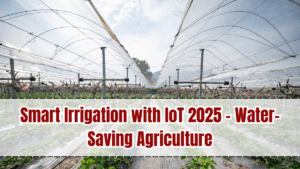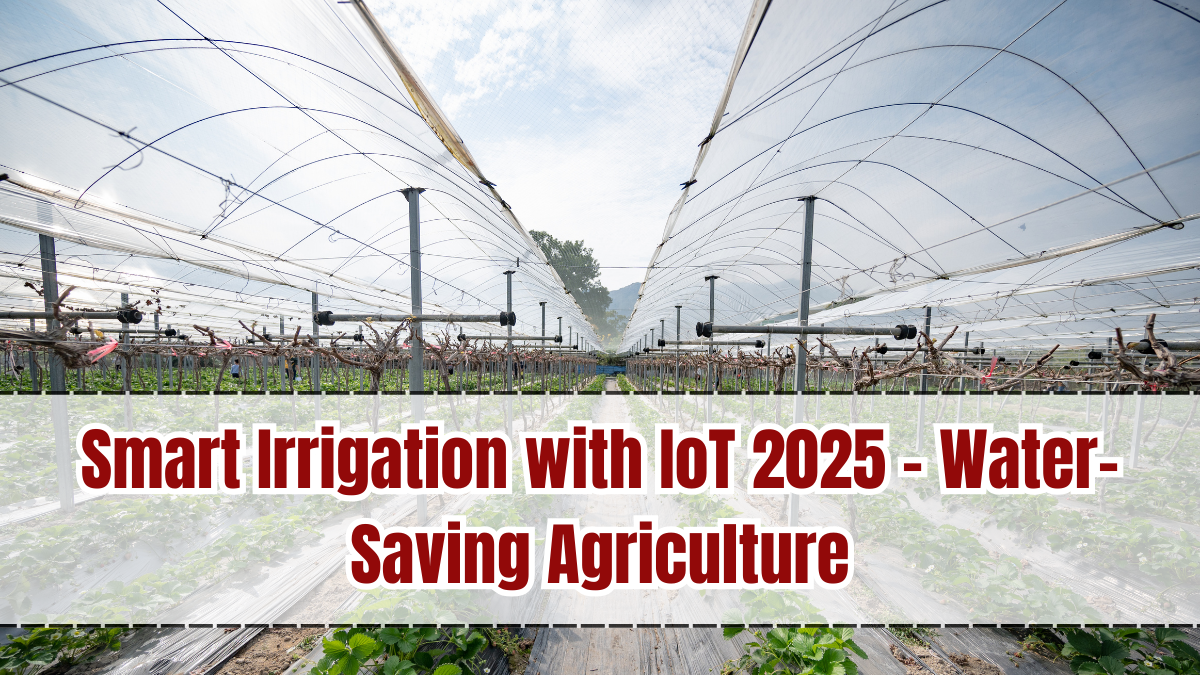Water scarcity is one of the biggest challenges facing agriculture today. Farmers often struggle to balance irrigation needs with limited resources, leading to either overwatering that wastes water or underwatering that harms crops. In 2025, Smart Irrigation with IoT is revolutionizing farming practices by introducing intelligent systems that monitor soil conditions, weather data, and crop needs in real time. This not only conserves water but also boosts productivity, making agriculture more sustainable and efficient.

What is Smart Irrigation with IoT?
Smart Irrigation with IoT (Internet of Things) refers to the use of connected sensors, devices, and automated systems that regulate water supply to crops based on actual requirements. Unlike traditional irrigation, which often relies on fixed schedules, IoT-enabled systems adapt dynamically.
Key components include:
-
Soil moisture sensors to track water levels in the soil.
-
Weather forecasting integration to predict rainfall and temperature changes.
-
Automated valves and pumps controlled by IoT devices.
-
Mobile apps that allow farmers to monitor and control irrigation remotely.
This ensures every drop of water is used effectively, reducing wastage while improving crop health.
Why It Matters in 2025
The adoption of Smart Irrigation with IoT 2025 is vital due to increasing water stress and climate uncertainty. Agriculture consumes nearly 70% of the world’s freshwater, and inefficient irrigation is a major cause of water shortages. In regions facing drought, farmers can no longer afford to depend on guesswork. By providing accurate, data-driven irrigation solutions, IoT ensures that crops get just the right amount of water, supporting food security and environmental sustainability.
Benefits of Smart Irrigation
The impact of IoT irrigation systems goes beyond just saving water. Farmers gain multiple advantages:
-
Water Conservation: Up to 40% less water is used compared to traditional methods.
-
Higher Yields: Crops receive the optimal amount of water, improving growth and productivity.
-
Cost Savings: Lower electricity and water bills reduce overall farming expenses.
-
Climate Adaptation: Systems adjust automatically during droughts or heavy rains.
-
Remote Control: Farmers can operate pumps and sprinklers from their smartphones.
This combination of efficiency and convenience is reshaping modern agriculture.
Role of Technology
Technology drives the success of IoT irrigation systems. Wireless networks connect devices across farmlands, while AI algorithms analyze data to provide precise recommendations. Cloud platforms store soil and weather data for long-term monitoring, helping farmers plan future seasons more effectively. Advanced IoT systems even integrate with drip irrigation and sprinkler systems, ensuring precise water delivery at the plant level. Together, these innovations turn traditional farms into smart farms.
Government and Industry Initiatives
Governments and private companies are heavily promoting IoT irrigation to address growing water challenges. Subsidies are being provided for farmers adopting smart systems, especially in drought-prone regions. Agri-tech startups are offering affordable IoT kits designed for small and marginal farmers. International organizations are also funding projects to spread water-saving technologies in developing countries. These initiatives ensure that Smart Irrigation with IoT is not just a luxury but a necessity accessible to farmers worldwide.
Future of Smart Irrigation
The future of smart irrigation lies in deeper integration with other technologies. By 2030, farms are expected to use AI-driven predictive analytics, drones for aerial crop monitoring, and blockchain-based platforms for transparent water usage tracking. With the expansion of 5G networks, even remote farmers will be able to adopt IoT irrigation seamlessly. Ultimately, agriculture will become more climate-resilient, ensuring that food production continues sustainably despite growing water challenges.
Conclusion
Smart Irrigation with IoT 2025 marks a turning point in sustainable agriculture. By combining technology, data, and automation, it empowers farmers to save water, reduce costs, and grow healthier crops. As governments, innovators, and farmers work together, IoT irrigation systems will not only secure food supplies but also protect one of our most precious resources — water. The shift to smart farming is no longer optional; it is the future of agriculture.
FAQs
What is Smart Irrigation with IoT 2025?
It is an intelligent system that uses IoT sensors and devices to regulate water supply to crops based on real-time soil and weather conditions.
How does IoT irrigation save water?
It delivers water only when and where it is needed, reducing wastage by up to 40% compared to traditional methods.
Are these systems affordable for small farmers?
Yes, with government subsidies and affordable IoT kits from startups, small farmers can also adopt this technology.
What technologies power smart irrigation?
It uses IoT sensors, AI algorithms, cloud platforms, and mobile apps to provide accurate irrigation management.
What is the future of smart irrigation?
Future systems will integrate with drones, predictive AI, and blockchain for transparent, efficient, and climate-resilient farming.
Click here to know more.
